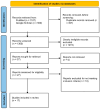Mapping the Implementation Determinants of Second Dose Measles Vaccination in the World Health Organization African Region: A Rapid Review
- PMID: 39204023
- PMCID: PMC11359529
- DOI: 10.3390/vaccines12080896
Mapping the Implementation Determinants of Second Dose Measles Vaccination in the World Health Organization African Region: A Rapid Review
Abstract
The second dose of measles-containing vaccines (MCV2) has significant programmatic relevance in the current immunisation landscape because it serves as both an opportunity to reduce measles immunity gaps and strengthen second year of life vaccination platforms. However, MCV2 coverage remains suboptimal across countries in the World Health Organization (WHO) African Region and this puts a significant number of children at risk of morbidity and mortality from measles despite the availability of an effective vaccine. There is an urgent need to strengthen the implementation of MCV2 but this requires a thorough and systematic understanding of contextual factors that influence it. The literature that describes the determinants of implementation of MCV2 in a manner that adequately accounts for the complexity of the implementation context is scarce. Therefore, the purpose of this rapid review was to explore the implementation determinants of MCV2 in the WHO African Region using systems thinking. Literature search in two databases (PubMed and Google Scholar) were conducted. After screening, a total of 17 eligible articles were included in the study. Thematic analysis of extracted data was performed to identify the implementation determinants, after which they were mapped using the Consolidated Framework for Implementation Research (CFIR). A causal loop diagram (CLD) was used to illustrate the linkages between identified determinants. We found 44 implementation determinants across the five CFIR domains, i.e., innovation, outer setting, inner setting, individual, and implementation process. The majority of identified determinants are within the individual domain followed by the inner setting domain. The CLD showed that multiple contingent connections and feedback relationships exist between the identified implementation determinants within and across CFIR domains. The linkages between the implementation determinants revealed three balancing and reinforcing loops each. The findings suggest that implementation determinants of second-dose measles vaccination in the WHO African Region are complex, with multiple interconnections and interdependencies, and this insight should guide subsequent policies. There is an urgent need for further implementation research with embedded CLD in specific settings to inform the design of tailored systemic strategies to improve the implementation effectiveness of MCV2.
Keywords: WHO African Region; childhood vaccination; consolidated framework for implementation research; implementation determinants; measles-containing vaccines; primary health care.
Conflict of interest statement
We declare no competing interests. The authors alone are responsible for the views expressed in this article and they do not necessarily represent the views, decisions, or policies of the institutions with which they are affiliated.
Figures
References
-
- Hedrich A.W. Monthly Estimates of the Child Population “Susceptible’ to Measles, 1900–1931, Baltimore, MD. Am. J. Epidemiol. 1933;17:613–636. doi: 10.1093/oxfordjournals.aje.a117929. - DOI
Publication types
Grants and funding
LinkOut - more resources
Full Text Sources




